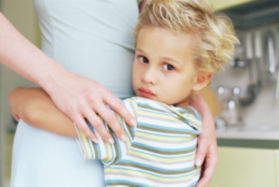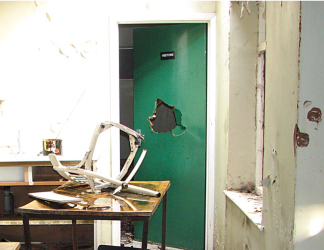Babies need to feel safe and secure with their parents and primary caregivers. They need to feel that they are loved and that their basic needs are going to be taken care of (Fig. 1). Reactive attachment disorders usually happen when a child does not develop solid and secure attachment to parents or primary caregivers. (For more information, see the typical and atypical sections of social/emotional development). RAD is a very sad disorder because it is preventable. A baby whose needs are met, who feels safe and secure and who is loved will not develop RAD. RAD happens when the parent and child do not bond with each other. This failure is never the baby’s fault.
Figure 1. Feeling loved
RAD is a very serious but rare disorder. It affects the way the child relates to and interacts with others. The child may appear typical and may behave typically, but he or she has a very serious disorder that needs to be addressed and taken care of. RAD is most often found in children who have been abused and/or neglected, and children who are in foster care, but RAD can occur to children from all races, ethnic and socio-economic backgrounds.
RAD has many symptoms. For a description of RAD symptoms in the early childhood years, please visit the zero to six part of this course.
In school-age children, the symptoms of RAD could go from one behavioral extreme to another. The child could show lots of affection, or the child could not show any affection at all. That is, the child could show lots of affection, or the child could not show any affection at all. The first extreme includes these behaviors:
- Child forms attachment to a variety of adults, including adults that the child does not know very well;
- Child clings to anyone in sight (Fig. 2);
- Child hugs and snuggles into anyone in sight;
- Child is overly eager to please.
Figure 2. Clinging to his mother
The second extreme includes these behaviors:
- Child does not let anyone get close to him or her emotionally;
- Child acts aloof and distant;
- Child does not let anyone hug him or her;
- Child throws very severe temper tantrums;
- Child is overly defiant of individuals who are a source of authority.
Other behaviors that are common to all children with RAD include:
- Moving from one extreme emotional state to another;
- Not trusting others;
- Not having any close friends;
- Lying;
- Cheating;
- Acting aggressively towards others (in some cases) (Fig. 3);
- Having poor self-esteem (see full Glossary);
- Being angry (Fig. 4) and sometimes showing rage;
- Being sad and sometimes suffering from depression.
Figure 3. Destroying property
Figure 4. Angry
Children with RAD need psychotherapy. If they are living with their biological parents, family therapy is usually recommended. They also need individual therapy. Parenting classes are also recommended if the child is living with the biological parents. It is highly recommended that whoever is taking care of the child (biological parent, grandparent, foster parent) learn about RAD. They should also learn what its symptoms and treatment options are. The therapy should be provided by a licensed clinical psychologist who has experience working with children and families. It is best that the therapist has experience working with children with RAD. Psycho-therapy sessions could be intensive (several times per week) and often last more than a year.
Some children with RAD do not perform as well as their peers in school. This is because they may not be very motivated to learn. Another reason could be the child’s poor self-esteem and his or her lack of feelings towards life. The classroom teacher can help the child get motivated to learn (with help from the special educator and the child’s psycho-therapist), by:
- Making sure the child knows that he or she is welcome and safe in the classroom;
- Making sure the child understands that he or she is wanted in the classroom;
- Being patient with the child, knowing that he or she may act out (for example, talk back to others) sometimes;
- Giving the child more time to complete in class and at home assignments;
- Giving the child as much consistency as possible in the classroom;
- Being firm but kind; these children need structure in their lives.
Although RAD appears to be a lifelong condition, proper treatment and therapy can help children with RAD grow up to be healthy individuals who are perfectly capable of forming happy and healthy relationships with others (Fig. 5).




